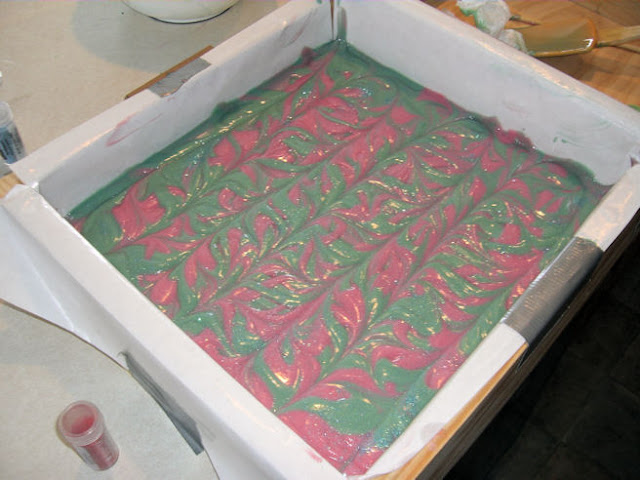I thought I'd blog a little bit about soap colorants. There are many ways to color cold and hot process soap. You have natural colorants which are, not usually, as vibrant as synthetic colors but lovely in their own right. You can achieve beautiful shades of pink, violets, browns, greens, oranges, yellows and many others, from plant materials, clays, minerals etc. There's always been a certain romance to the idea of 100% natural soap, made of nothing but what mother nature shares with us, stirred with a wooden spoon in our grandmother's worn apron. For years a good couple of spoonfuls of cocoa or allspice was what soapmaker's used to get a lovely deep brown, or some alkanet root to get muted shades of violet. These natural elements are still used and often preferred by today's soapmakers.
One can also utilize a vast array of pigments such as micas, ultramarines and oxides. Until the FDA stepped in and took issue with the purity of mining these pigments, they are now manufactured in labs. Iron oxides, in nature, are often filled with toxic metals like lead, arsenic, mercury, antimony and selenium so safety warranted a change.
And lastly, you have the many differen't types of FD&C colorants which are not natural and manufactured in a lab, as well. They provide a very wide range of colors and are really easy to use once you get the hang of it.
Is your head spinning yet? How then, does anyone choose? A lot of it comes down to preference, ease of use, and stability. What do I mean by stability? Well, often times in soapmaking, the chemical process soap needs to go through - called saponification - creates reactions in alkaline environments that do all sorts of wacky things to colors. You may start out with a beautiful royal purple poured into your soap mold, and when you come back a few hours later to check on it, you have something that closely resembles a greenish gray vomit. Ew. You may mix your little heart out to find that "perfect" shade of red, and end up with hot pink. This is why colorants require testing testing testing!
Let me give you an example. Tonight, I poured a soap with two separate colors, and did a simple slab swirl. I used a shamrock green mica (which is gorgeous in my lip balms, by the way!), and a small amount of a cellini red mica. Take a look at the photo below...
As you can see by these photos taken just after pouring, I have a medium shade shamrock green and a dark pink. Everything looks like it should and all seems to be right in the world. Here's a closeup:
Now take a look at the soap in the mold, just a couple of hours later:..(there is also some microfine blue glitter on top if you're wondering what the specks are :)
No more shamrock green! What happened is that this particular mica is not stable in cold process soap and went through a color change commonly known as "morphing". Now we have a very light tan color instead of green. Sometimes the color just plain disappears altogether! Don't even get me started on the havoc fragrance oils can wreak on colors too! So you see...much planning and testing goes into soapmaking, which can be very frustrating...but never boring. Sometimes you just have to roll with the outcome and adjust your "vision" to meet your soap reality. So, the next time your dark pink and shamrock green soap turns light pink and tan? Remember these 5 little words...
I meant to do that. :)
Until my next post...thanx for reading!
UPDATE! The color change continues! This morning, after a full 20 hours, the colors have morphed again, back to green and pink. They are softer and less pronounced now, but this just goes to show you once more, that colorants have all sorts of surprises in store. :)
Happy soaping!





Great post and oh so true. I know more about the color wheel now than I ever did. The green was pretty but the tan looks great too since the pink stayed. I bet it smells great! I had a " I meant to do that" moment in my soapmaking today as well. I'll send you an email and fill you in. :)
ReplyDeleteHi!
ReplyDeleteNice blog!! I love the swirls you made, I'm still not very good at swirling, sob. But I promised I'll improve on that one.
Can I ask you something? Do you have any idea on how to get natural green colourant? I've used green clay, which turns out ok, but I'd like to add something else to get a brighter green, maybe using HP (so the colour is more likely to stay).
Thanks, and happy soapmaking!!
Hi! Yes, spirulina makes a nice green!
ReplyDelete